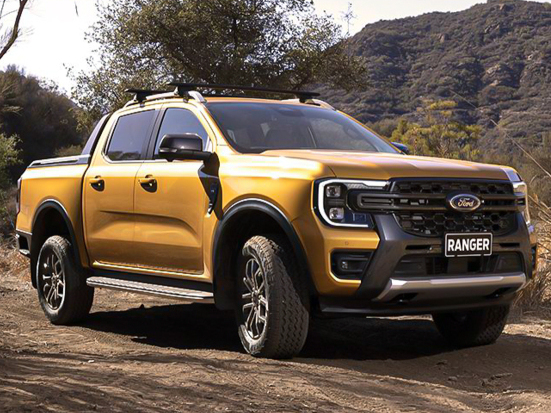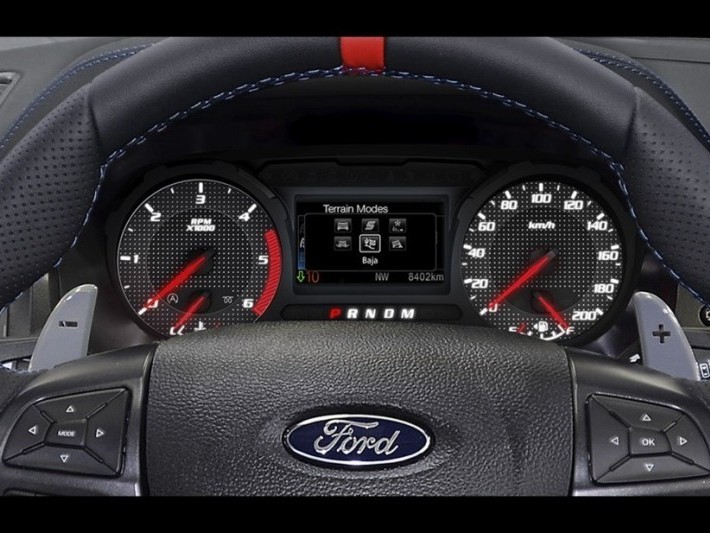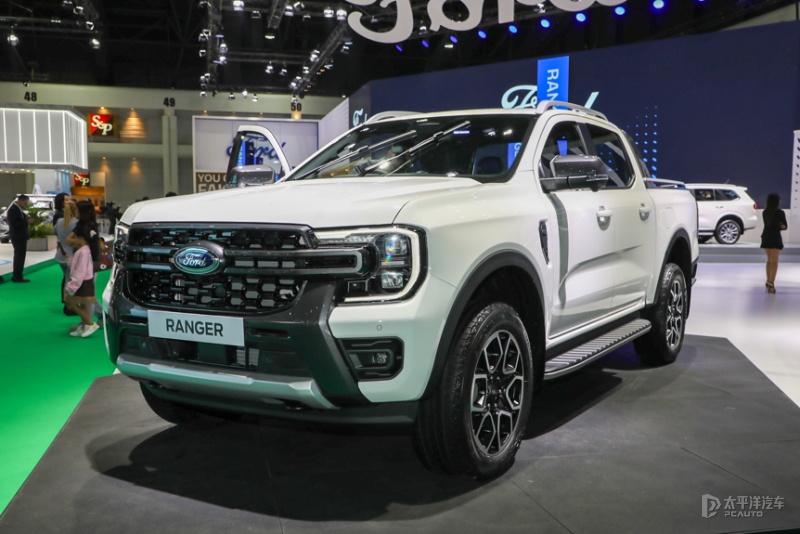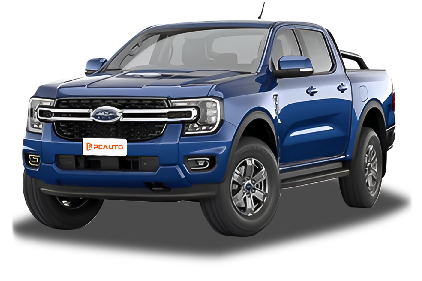Q
What is the 0 60 time for the 2023 Ford Ranger?
The 2023 Ford Ranger's 0-100 km/h acceleration time varies by powertrain. The Raptor performance variant with the 2.0L four-cylinder bi-turbo diesel engine can do it in around 6.8 seconds, while the regular 3.0L V6 turbo diesel model takes about 7.9 seconds. Actual performance can also be affected by transmission tuning, payload, and road conditions. This pickup features an advanced 10-speed automatic transmission and four-wheel drive system, balancing off-road capability with on-road performance, placing its acceleration in the upper-middle range among competitors. It's worth noting that acceleration tests for pickups are usually done with an empty load; real-world acceleration will decrease when carrying cargo or towing a trailer. These figures mainly showcase the vehicle's power reserve, but in daily use, low-end torque output is more important—especially for practical scenarios like hauling or climbing hills.
Special Disclaimer: This content is published by users and does not represent the views or position of PCauto.
Related Q&A
Q
What is the V6 engine in the Raptor 2023?
The 2023 Ford Raptor is powered by a 3.5-liter EcoBoost twin-turbocharged V6 engine, renowned for its impressive power delivery and fuel efficiency. It cranks out 450 horsepower and 691 Nm of peak torque, paired with a 10-speed automatic transmission that delivers robust acceleration and off-road capability. The V6 design maintains strong power output while being lighter than a traditional V8, enhancing overall vehicle handling and fuel economy. This engine also features advanced turbocharging tech and direct injection, churning out ample torque at low revs—perfect for both off-roading adventures and highway cruises. For performance truck enthusiasts, the Raptor's V6 doesn't just handle daily drives; it excels in tough terrain with outstanding capability. Plus, the turbocharging setup strikes a solid balance between eco-friendliness and performance, keeping up with modern automotive tech trends.
Q
How does the 2023 Raptor compare to the TRX?
The 2023 Ford F-150 Raptor and Ram 1500 TRX are both icons of high-performance full-size pickups, but their design philosophies and performance focuses set them apart. The Raptor packs a 3.5L EcoBoost V6 twin-turbo engine with 450 horsepower, emphasizing high-speed off-road capability and lightweight construction. It comes with upgraded FOX Live Valve dampers and a smarter terrain management system, making it ideal for long-distance trail runs and complex landscapes. The TRX, on the other hand, rocks a 6.2L supercharged Hemi V8 cranking out a beastly 702 horsepower, prioritizing straight-line acceleration and extreme off-road dominance. Equipped with Bilstein Black Hawk e2 adaptive shocks, it’s more for folks chasing raw power and old-school rugged off-roading. Inside, the Raptor leans into utility and tech, standard with a 12-inch touchscreen and SYNC 4, while the TRX ups the luxury ante with suede seats and premium audio. Neither is a fuel sipper, but the TRX’s V8 definitely drinks more. Choosing between them boils down to your needs: the Raptor suits those who love bombing through deserts and want balanced performance, while the TRX is the go-to for max horsepower and that classic American muscle vibe. Also, keep in mind road adaptability if you’re using these high-performance trucks locally—their wide bodies and off-road suspension can feel a bit clunky around town.
Q
How much horsepower does a 2023 Raptor have?
The 2023 Ford Raptor comes with a 3.5-liter EcoBoost V6 twin-turbo engine, cranking out 450 horsepower and 691 Nm of peak torque, mated to a 10-speed automatic transmission. It’s got some serious muscle, perfect for off-roading and high-speed driving. This truck also packs an advanced 4WD system and terrain management system, making it a breeze to handle all kinds of tough road conditions. If you’re into high-performance pickups, the Raptor’s a solid choice—it’s not just powerful, but also has great suspension tuning and off-road chops, plus it’s pretty comfortable for daily driving. On top of that, the EcoBoost tech balances power and fuel efficiency; sure, it drinks more than regular models, but it’s actually pretty reasonable for a performance truck in its class. And if you need even more grunt, there’s the Raptor R, which rocks a 5.2-liter supercharged V8 with over 700 horsepower—though it’ll cost you more upfront and at the pump.
Q
Does the 2023 Raptor have self-driving?
The 2023 Ford Raptor doesn't come with full self-driving capability, but it does pack some advanced driver-assistance systems. Think adaptive cruise control, lane-keeping assist, and automatic emergency braking—stuff that can give you a semi-automated driving experience under certain conditions. Important to note, though: these systems still need the driver to stay focused and ready to take over at any time to keep things safe. A lot of high-performance pickups and SUVs on the market these days have similar driver-assistance tech, but it's all designed to cut down on driver fatigue, not replace the person behind the wheel. If you're into autonomous driving tech, keep an eye on some of the newer electric vehicle brands—they tend to pour more R&D into automated driving. But even the fanciest systems out there are still in the limited-condition, driver-assist phase. Fully self-driving cars still have a long road ahead, both in terms of regulations and technology.
Q
How heavy is a 2023 Ford Raptor?
The 2023 Ford Raptor has a curb weight of around 2,615 kilograms, mostly coming from its tough high-strength steel frame chassis, all-aluminum body, and that beastly 3.5-liter EcoBoost V6 engine. For a high-performance off-road pickup, this weight works—it helps boost stability and durability when you're tackling rough terrain. What's cool is that even with that heft, the Raptor still handles pretty well and isn't a total gas guzzler, thanks to lightweight materials and a suspension setup that's been dialed in just right. If you're into off-roading, this weight gives you the security you need without killing the fun factor. And if you regularly haul gear or tow stuff, the Raptor's max payload and towing capacity are seriously impressive—definitely up to all kinds of practical tasks. It's that rare truck that blends performance and utility like a pro.
Q
How much horsepower does a 2023 Ford Ranger Raptor 3.0 V6 EcoBoost have?
The 2023 Ford Ranger Raptor's 3.0-liter V6 EcoBoost twin-turbo engine cranks out 392 horsepower and 583 Nm of torque, a massive step up from the previous gen's 2.0-liter four-cylinder. This high-performance pickup also rocks a 10-speed auto transmission and full-time 4WD system, balancing off-road capability with on-road manners. EcoBoost tech pairs turbocharging with direct injection to boost fuel efficiency while ramping up low-end torque, making it solid for any terrain. Plus, it gets exclusive setups like Baja mode, FOX 2.5-inch live valve shocks, 283mm of ground clearance, and 850mm water fording depth—all of which keep it handling like a champ on high-speed gravel or rough trails. If you're after a top-tier off-road experience, this one's definitely worth a look.
Q
How much horsepower does a 2023 Ranger have?
The 2023 Ford Ranger comes with a variety of powertrain options, with specific horsepower outputs depending on the engine configuration. The most powerful version is equipped with a 2.0-liter four-cylinder twin-turbo diesel engine, delivering 210 horsepower and 500 Nm of torque, ideal for users needing strong performance. The entry-level model, on the other hand, features a 2.0-liter single-turbo diesel engine, providing 170 horsepower and 405 Nm of torque, striking a balance between fuel economy and performance. Additionally, some markets offer a 2.3-liter turbocharged gasoline engine option, producing around 270 horsepower, suitable for drivers who prefer petrol power. The Ranger's powertrain has been meticulously tuned to suit not only daily driving but also off-road and load-carrying needs. Its 10-speed automatic transmission further enhances power delivery smoothness and fuel efficiency. If you're interested in pickup trucks, you might also want to check out other models in the same class, each with its own strengths in power, cargo capacity, and tech features. It's advisable to test drive and compare based on your actual needs before making a decision.
Q
What transmission is in the 2023 Ford Ranger?
The 2023 Ford Ranger offers two transmission options based on different powertrain configurations. The 2.0-liter single-turbo or bi-turbo diesel engines are paired with a 10-speed automatic transmission, while the 3.0-liter V6 turbocharged diesel engine comes with an upgraded, more robust 10-speed automatic transmission. Both gearboxes have been specifically tuned to balance off-road capability with on-road driving smoothness. The advantage of the 10-speed transmission lies in its closely spaced gear ratios, which optimize power delivery and improve fuel efficiency, particularly excelling during low-speed climbing or high-speed cruising. It's worth noting that this transmission works in conjunction with Ford's Terrain Management System, automatically adapting to challenging road conditions like sand and mud. For users who frequently need to carry heavy loads or tow, the transmission's built-in Tow/Haul mode provides more abundant torque output by delaying upshifts. In terms of maintenance, it's recommended to check the transmission fluid condition every 60,000 kilometers. If you regularly engage in high-intensity off-roading or towing, the maintenance interval should be shortened, and using the factory-specified transmission fluid is essential to ensure optimal durability.
Q
How much does a brand new 2023 Ford Ranger cost?
The 2023 Ford Ranger's price varies depending on the trim and configuration. The base XL model starts at around RM100,000, while the top-spec Wildtrak could exceed RM160,000. For the latest pricing, it's best to check with your local dealer. This pickup truck is powered by a 2.0-liter turbocharged diesel engine, delivering solid power and fuel efficiency, along with good payload and towing capacities, making it suitable for various road conditions and usage scenarios. The Ranger also comes loaded with safety features, including adaptive cruise control, lane-keeping assist, and automatic emergency braking. As a globally popular midsize pickup, it has a strong reputation for reliability, durability, and off-road capability. Recent upgrades to its exterior and interior have further enhanced its tech feel and comfort, making it one of the top contenders in its class.
Q
Where is the 2023 Ford Ranger built?
The 2023 Ford Ranger is primarily built at the Ford Southeast Asia Manufacturing Center in Rayong, Thailand – a key production hub for Ford in the Asia-Pacific region, supplying multiple markets including the local one. This pickup rides on a global platform, with its chassis tuning and powertrain specifically optimized for Southeast Asian road conditions. Take the 2.0L bi-turbo diesel engine, for example – it balances durability in tropical climates with the need for strong torque output. It’s worth noting that the current Ranger shares some tech with the Volkswagen Amarok but retains Ford’s signature driving feel, with things like the electric power steering and Terrain Management System getting unique calibrations. For owners who love modifying their rides, the body-on-frame construction and robust ecosystem of factory accessories offer solid upgrade potential, from skid plates to bed roll bars – you can find a solution for just about anything. On the after-sales front, authorized dealers across Malaysia provide maintenance support up to Ford’s global standards, including specialized synthetic oils and diagnostic equipment.
Latest Q&A
Q
How much horsepower does a 2020 Triton have?
The 2020 Triton packs 110 horsepower. It's powered by a 2.5-liter (2477cc) diesel engine. This engine cranks out maximum power at 4000 rpm and peak torque at 2000 rpm. It delivers plenty of oomph for daily driving and all sorts of tasks, letting the truck handle different road conditions and payload demands with ease. There might be some performance variations across different trims, but overall, they all offer a reliable and practical driving experience.
Q
What is the fuel consumption of a Mitsubishi Triton 2020?
The fuel economy of the 2020 Mitsubishi Triton varies depending on the specific trim and driving conditions. Official figures show that the version equipped with the 2.4-liter MIVEC turbocharged diesel engine (model 4N15) has a combined fuel consumption of approximately 8.6 liters per 100 kilometers. Manual transmission models might be slightly lower at 8.2 liters per 100 kilometers, while automatic variants tend to be a bit higher due to transmission tuning. In real-world driving, if you frequently carry heavy loads or go off-roading, fuel consumption could rise to 10-12 liters per 100 kilometers. This engine features common rail injection technology and a variable geometry turbocharger, balancing low-end torque with high-rev efficiency. The accompanying Super Select 4WD-II system maintains decent fuel economy even in 4H mode. It's important to note that diesel vehicle fuel consumption is significantly affected by fuel quality; using B7 or higher-grade diesel is recommended to achieve optimal performance. Additionally, regular maintenance of the fuel filter and injectors is crucial for keeping fuel consumption in check. Rivals in the same pickup segment like the Toyota Hilux and Ford Ranger have similar fuel economy figures, but the Triton's lightweight chassis design gives it a slight edge when unladen. Adding a bed cover or reducing highway cruising RPM can further optimize fuel efficiency.
Q
How much does a 2020 Mitsubishi cost?
The specific price of a 2020 Mitsubishi model depends on the vehicle type and configuration. For example, a used Mitsubishi Triton pickup truck costs around 80,000 to 120,000 Malaysian Ringgit, while the ASX compact SUV ranges from 70,000 to 100,000 Malaysian Ringgit. Actual prices are affected by condition, mileage, and additional features. Mitsubishi vehicles are known for durability and practicality. The Triton, for instance, suits users needing strong power and off-road capability, while the ASX is better for city driving with good fuel efficiency. When buying a used car, it's advisable to check maintenance records and vehicle history to ensure no major accidents. Additionally, Mitsubishi has an extensive after-sales network, sufficient parts supply, and relatively reasonable maintenance costs—all factors worth considering.
Q
How much is a Mitsubishi Triton 2020?
The 2020 Mitsubishi Triton Quest is priced at RM 81,390. This model runs on diesel fuel and is powered by a 2.5-liter engine with a maximum output of 110 horsepower. It comes with a 5-year or 100,000-kilometer warranty. The spacious interior and large 75-liter fuel tank make it suitable for various needs. Its 4x4 drive system and manual transmission provide decent control over different terrains. The vehicle is also equipped with standard safety features like ABS and multiple airbags to ensure driving safety.
Q
What is the fuel consumption of the Harrier 2018?
The fuel economy of the 2018 Harrier varies depending on the drivetrain and powertrain configuration. The 2.0L naturally aspirated front-wheel drive version has a combined fuel consumption of approximately 6.8L/100km, while the 2.0L turbocharged all-wheel drive version is slightly higher at around 7.3L/100km. Actual fuel consumption can be affected by driving habits, road conditions, and maintenance status. This vehicle features optimized engine technology and a lightweight body design, which help improve fuel efficiency, and it also comes with an ECO driving mode to further reduce fuel consumption. In daily driving, maintaining smooth acceleration, using cruise control properly, and regularly replacing the air filter can all improve fuel efficiency. It's worth noting that hybrid models are generally more fuel-efficient than traditional gasoline-powered vehicles. If energy conservation is a priority, the hybrid version may be a better choice, but it's necessary to balance the purchase cost with long-term fuel savings.
View MoreRelated News

2025 Ford Ranger WildTrak launched, the most powerful diesel version in the Ranger lineup
MichaelAug 25, 2025

Is the Ford Ranger V6 about to enter Malaysia?
LienAug 13, 2025

Reviewing the Ford Ranger: The Dual Advantages of Rugged Appearance and Powerful Performance
Kevin WongApr 21, 2025

"Starting from RM 170,888! Detailed Explanation of Ford Ranger's Configuration and Performance, a Synonym for Practicality and Versatility?"
AshleySep 20, 2024

Ford Ranger: A Safe, Reliable, and Economical Choice of Pickup
LienMay 2, 2024
View More


















Pros
Cons